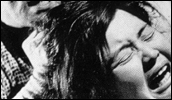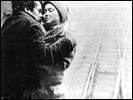Intentions of Murder
- Year
- 1964
- Original title
- Akai Satsui
- Japanese title
- 赤い殺意
- Director
- Cast
- Running time
- 145 minutes
- Published
- 31 August 2001


by Jasper Sharp
Approaching Shohei Imamura's Intentions of Murder both requires and rewards the greatest of patience on the behalf of the viewer. At almost two and a half hours in length, its tale of a low-caste household drudge who transcends her lowly situation - not through any reaction against it, but rather by accepting her place within the order of things - will provide rather an endurance test for those unfamiliar with the ethos of the director. However, it also marks the most complete consolidation of the themes that inform his initial cycle of features in the late 1950s and early 1960s, and also puts forward a strangely subversive view of "modern" Japan, at odds with the image promoted in other films of the time.
Born of peasant stock Sadako (Harakawa), the dull-witted and lumpen lynchpin of the piece, leads a thankless day-to-day existence tending the tumbledown shanty dwelling that she inhabits with her unaffectionate common-law husband Koichi (Nishimura) whilst playing mother to his son Masaru, a child from a former marriage whom she cares for as if her own. Her prostitute grandmother and her lowly café waitress mother now dead (the latter having hung herself), Sadako dutifully and uncomplainingly accepts her tenuous position within a society that she is only marginally a part of, as Koichi's shrewish mother regularly reminds her how lucky she is to have been taken in by her son.
One day, when her husband is away on a work conference, the house is broken into by a thief, Hiraoka (Tsuyuguchi, who later appeared as searching for the missing man in the Imamura's A Man Vanishes / Ningen Johatsu, 1967). The intruder rapes her and leaves with the words "If you tell no one, no one will know". When Hiraoka returns a few days later she yields once more. Finding herself pregnant by him, she allows herself to be tempted by his offer to leave her cramped and oppressive environment to start a new life in Tokyo with him. But is an uncertain future with a neurotic fugitive with a heart condition really what she desires?
The dim-witted Sadako makes for an unlikely heroine, a typically earthy Imamurian creation running counter to standard depictions of the female role within the Japanese family structure, that of either mothers or wives - indeed, Imamura's adhoc family unit is the complete antithesis of the middle-class nuclear families being portrayed, for example, in the well-mannered and immaculately turned-out works of his early mentor Yasujiro Ozu.
Yet despite her pudgy features and her slow and unaffected manner, the director obviously has a lot of respect and affection for his honest and well-meaning lead. Her unsophisticated yet vital presence is at odds with those of the weedy, devious men that surround her - her partner Koichi is a sickly man often seen wearing a pollution mask, and Masaru's ability to continue the family name is later called into question. Koichi refuses to grant her any official status through marriage, nor any legal claim to Masaru, and is meanwhile conducting an affair with his bookish and bespectacled library assistant.
Sensual and instinctive, her presence embodies a conflict between desire and duty, underscoring Imamura's recurrent maxim that there is a world of difference between the public face that the Japanese put forward and of the individual, more instinctive side. Her giving herself to pleasure during the initial assault is no male wish-fulfilment fantasy, but an entirely credible emotional reaction given her purely functional role within the makeshift family unit on which she is dependent upon for her (albeit lowly) social position.
This conflict between simple biological urges and societal demands is immediately underscored when after being raped the first time, she retires to commit suicide, as custom dictates. As she prepares the knife with which to fulfil her duty, she is distracted by the rumbling of her stomach, and so she gets up to prepare some food. By the time she has fed herself, Masaru has returned from school and its back to domesticity again, her original intention forgotten.
Typically for the director, our heroine's plight is objectified by way of reference to the animal kingdom, most overtly in Masaru's pet white mouse that futilely spins around in its wheel in the corner of the cluttered apartment symbolising her inability to escape from the cycle forged by her female predecessors, whilst adding a further dynamism to the already busy shot compositions (Masaru is constantly hyper-active, running or leaping in the background in the domestic scenes in the cramped living room). The silkworm motif is also crucial. After being raped, Sadako has a flashback to her childhood, where she is angrily scolded by her mother for playing with one that is crawling along her thigh. The meaning of this cryptic image becomes a lot clearer at the film's coda.
Another dimension is added by Imamura's focus on the encroachment of the new technology running concurrent with Japan's rapid modernisation upon the lives of his characters. The frequent crashing past of the express train along the track that borders the bottom of the garden, ominously sounding its horn at key dramatic points in the film initially suggests that such new developments are to be seen as an oppressive force, hemming in Sadako and with her the lower class neighbours in their cramped rows of houses - compare this with the rather low-key approach taken by Ozu in his 1961 film Good Morning (Ohayo), where the arrival of television in its middle class household is merely utilised as a method to elicit its simple, yet charming drama. However, when Sadako flees with Hiraoka by this means of transport, the film opens up considerably into a stunningly shot snowscape, hinting that these same forces can also provide an escape route. Similarly, in an early scene the heroine is seen failing to cope with the new sowing machine delivered to the house, though by the end of the film, she has mastered it. The message seems to be that though the ceaseless march of progress is inevitable, it is necessary to come to terms with these changes to survive.
Despite being beautifully photographed in widescreen monochrome and technically perfect, upon an initial viewing Imamura's film seems unwieldy, cluttered, and unfocused, with a plethora of flashbacks, narrative dead ends, and dream sequences permeating its lengthy running time. Though admittedly overlong, upon further analysis it is a faultlessly constructed model of sophistication, which uses its messy appearance to suggest that beneath the ordered chaos of modernity with all of its artificial constraints, it is characters such as Sadako that provide the beating heart that enables society to continue.